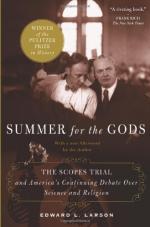
|
| Name: _________________________ | Period: ___________________ |
This test consists of 15 multiple choice questions and 5 short answer questions.
Multiple Choice Questions
1. In June 1925, Scopes meets with which three well-known scientists who help shape public response to his trial?
(a) Henry Fairfield Osborn, J. McKeen Cattell, Charles B. Davenport.
(b) Henry Fairfield Osborn, J. McKeen Cattell, John T. Raulston.
(c) Henry Fairfield Osborn, Ben G. McKenzie, Charles B. Davenport.
(d) George W. Rappleyea, J. McKeen Cattell, Charles B. Davenport.
2. The prosecution argues that the law simply bars teaching evolution, regardless of what?
(a) Evolution is or is not.
(b) Evolution is.
(c) Evolution is not.
(d) Evolution is commonly thought to mean.
3. Only Yesterday is written by Harper's editor Frederick Lewis Allen and published in which year?
(a) 1941.
(b) 1961.
(c) 1931.
(d) 1951.
4. Scopes leaves following the verdict to study where?
(a) University of Chicago.
(b) Princeton University.
(c) University of Iowa.
(d) University of Tennessee.
5. The Tennessee Supreme Court takes what action regarding Scopes' conviction?
(a) Overturns.
(b) Upholds.
(c) Sustains.
(d) Reverts to lower court.
6. Middle ground exists between the modernists and fundamentalists, and it garners what amount of attention?
(a) Little.
(b) Moderate.
(c) Significant.
(d) Virtually none.
7. Both sides use the media in attempts to throw off the other. How?
(a) Both sides broadcasting much falsely to confuse.
(b) Both sides broadcasting as much as possible to confuse.
(c) Keeping quiet or broadcasting everything possible.
(d) Keeping quiet or broadcasting virtually all falsely.
8. Tennessee outlaws teaching that denies the biblical account of creation, so the defense wants to show what?
(a) Biblical interpretations differ.
(b) Biblical interpretations, evolution theory are compatible.
(c) Evolution theory is proven, biblical interpretations differ.
(d) Biblical interpretations are inaccurate.
9. Darrow is what for contempt due to comments he makes the previous Friday; charges the judge dismisses when he apologizes?
(a) Fined.
(b) Arrested.
(c) Cited.
(d) Jailed.
10. Because the defense opens with a witness other than Scopes, what does this mean?
(a) He will testify before the court last.
(b) He will not be cross-examined.
(c) He will initially be examined by the prosecution.
(d) He will not testify before the court.
11. Who attends a sermon Bryan gives in Dayton on Sunday (12th) immediately after the first trial date?
(a) Most of the jury.
(b) Darrow.
(c) Scopes.
(d) Presiding judge.
12. Once proceedings are over, the jury returns to the room for instructions, having heard how much testimony and questioning?
(a) 4 hours testimony, no questioning.
(b) 4 hours testimony, minimal questioning.
(c) 2 hours testimony, minimal questioning.
(d) 2 hours testimony, no questioning.
13. Internal conflict, confusion, and maneuvering characterize which side in the days before the state supreme court hears the case?
(a) Primarily the prosecution.
(b) Primarily the defense.
(c) Both the defense, prosecution.
(d) Neither the defense, prosecution.
14. The defense challenges the anti-evolution statute's constitutionality on the second day using a motion to what?
(a) Quash, as the text has approval.
(b) Move the trial, given the publicity.
(c) Quash the indictment.
(d) Move the trial's given location.
15. Prosecutors open by briefly arguing that Scopes violates the law by teaching that humans evolve from other life forms and what?
(a) This denies the biblical account of creation.
(b) This cannot be taught with the biblical account of creation.
(c) Scopes knew that teaching evolution violates the law.
(d) Scopes does not believe in the Bible.
Short Answer Questions
1. Most national politicians publicly choose what position on the trial?
2. Bryan begins to believe that the trial needs to exclude any discussion on what?
3. Defense counters that the prosecution's opening is all a matter of interpretation and what?
4. Bryan concedes that he interprets the Bible and at times, he does not know the answers to what?
5. Who, at the time, sees the trial as a clear-cut victory for the defense or the prosecution?
|
This section contains 621 words (approx. 3 pages at 300 words per page) |

|




